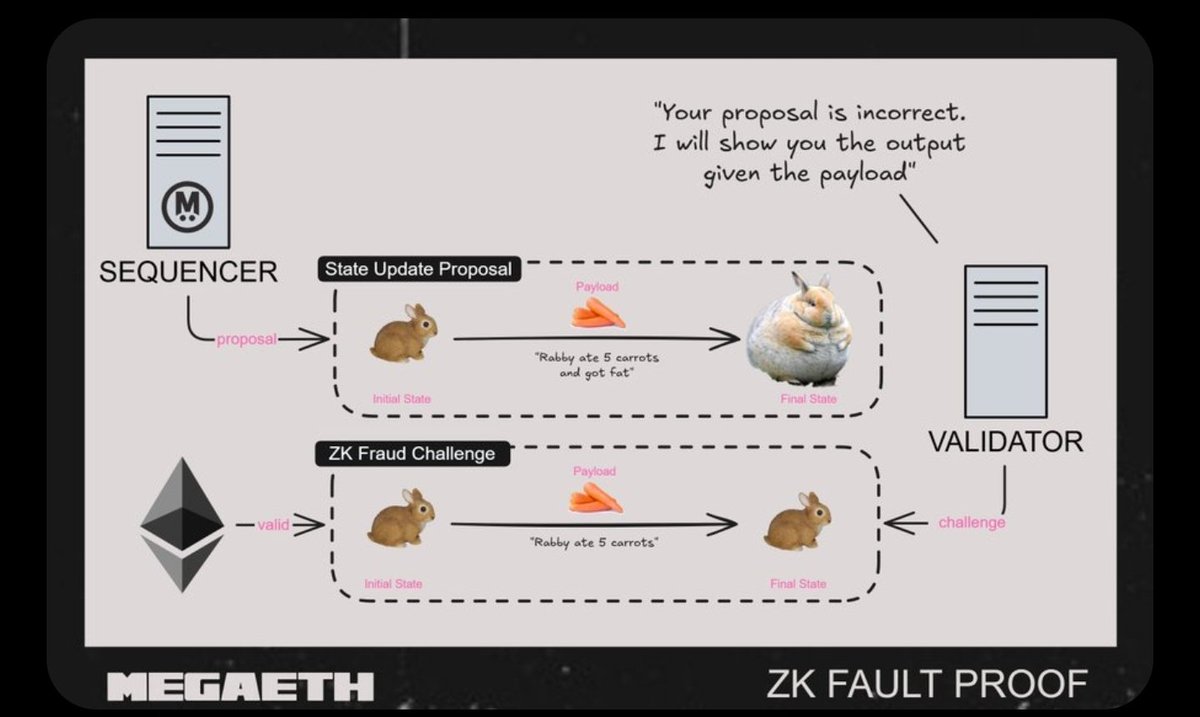[GUEST ACCESS MODE: Data is scrambled or limited to provide examples. Make requests using your API key to unlock full data. Check https://lunarcrush.ai/auth for authentication information.]  Pedrocrypt (🌪️, 💥) [@pedrocrypt1](/creator/twitter/pedrocrypt1) on x 6080 followers Created: 2025-07-23 22:42:50 UTC how megaeth is rethinking fraud proofs with zk, risczero, and eigenDA first, what’s the deal with fraud proof? 》》》》 in optimistic layer 2s (like megaeth), we assume people are honest... but just in case someone tries to cheat, there’s a system in place called a fraud proof. think of it like this: the sequencer (the guy proposing blocks) says, “hey, i ran these transactions, and here’s the result. now, if someone thinks he messed up (or lied), they can challenge it kind of like saying hold up, that’s not right. but instead of everyone yelling in a courtroom, there’s a structured way to sort it out. the megaeth way——» zk fraud proofs (non-interactive) megaeth flips the whole system. instead of a debate, the challenger just submits a single zero-knowledge proof that shows the sequencer’s block is invalid. no back-and-forth. no time-wasting. no chance to mess with the process. here’s how it works: >> the challenger takes the block data and runs it through risczero’s zkvm >> if fraud is detected, they generate a zk proof that says: “hey, when i actually ran this, the result didn’t match what the sequencer claimed” >> this proof is then submitted to ethereum in one transaction ethereum checks it, and if it’s valid, the fake block gets rejected and the sequencer gets slashed the best part? the sequencer can’t interfere or argue they just take the L. powered by eigenDA for raw data access for all this to work, challengers need access to the original block data. without it, they can’t run the zk fraud proof. that’s where eigenDA comes in. it’s a decentralized data layer that makes sure the block data is always available, secure, and ready to be used. here’s how it flows: • the sequencer publishes block data to eigenda • only a small reference is posted to ethereum • eigenda guarantees that the full data is there and can't be hidden • anyone can grab that data, run it through the zkvm, and generate a fraud proof if needed in short: » megaeth ditches the old interactive fraud games » replaces them with one-shot zk fraud proofs » no more griefing » no more wasted time » way shorter time-to-finality » risczero handles the zk compute » eigenDA makes sure the data is always there this combo makes megaeth’s system faster, cheaper, and harder to attack, while still letting anyone challenge bad behavior. it’s like having a silent referee who can instantly call out a foul and roll the tape, no arguments needed.  XXX engagements  **Related Topics** [blocks](/topic/blocks) [zk](/topic/zk) [megaeth](/topic/megaeth) [Post Link](https://x.com/pedrocrypt1/status/1948151849514651726)
[GUEST ACCESS MODE: Data is scrambled or limited to provide examples. Make requests using your API key to unlock full data. Check https://lunarcrush.ai/auth for authentication information.]
 Pedrocrypt (🌪️, 💥) @pedrocrypt1 on x 6080 followers
Created: 2025-07-23 22:42:50 UTC
Pedrocrypt (🌪️, 💥) @pedrocrypt1 on x 6080 followers
Created: 2025-07-23 22:42:50 UTC
how megaeth is rethinking fraud proofs with zk, risczero, and eigenDA
first, what’s the deal with fraud proof? 》》》》
in optimistic layer 2s (like megaeth), we assume people are honest... but just in case someone tries to cheat, there’s a system in place called a fraud proof.
think of it like this: the sequencer (the guy proposing blocks) says, “hey, i ran these transactions, and here’s the result. now, if someone thinks he messed up (or lied), they can challenge it kind of like saying hold up, that’s not right. but instead of everyone yelling in a courtroom, there’s a structured way to sort it out.
the megaeth way——» zk fraud proofs (non-interactive) megaeth flips the whole system. instead of a debate, the challenger just submits a single zero-knowledge proof that shows the sequencer’s block is invalid. no back-and-forth. no time-wasting. no chance to mess with the process.
here’s how it works:
the challenger takes the block data and runs it through risczero’s zkvm if fraud is detected, they generate a zk proof that says: “hey, when i actually ran this, the result didn’t match what the sequencer claimed”
this proof is then submitted to ethereum in one transaction ethereum checks it, and if it’s valid, the fake block gets rejected and the sequencer gets slashed the best part? the sequencer can’t interfere or argue they just take the L.
powered by eigenDA for raw data access for all this to work, challengers need access to the original block data. without it, they can’t run the zk fraud proof. that’s where eigenDA comes in. it’s a decentralized data layer that makes sure the block data is always available, secure, and ready to be used.
here’s how it flows: • the sequencer publishes block data to eigenda • only a small reference is posted to ethereum • eigenda guarantees that the full data is there and can't be hidden • anyone can grab that data, run it through the zkvm, and generate a fraud proof if needed
in short: » megaeth ditches the old interactive fraud games » replaces them with one-shot zk fraud proofs » no more griefing » no more wasted time » way shorter time-to-finality » risczero handles the zk compute » eigenDA makes sure the data is always there
this combo makes megaeth’s system faster, cheaper, and harder to attack, while still letting anyone challenge bad behavior. it’s like having a silent referee who can instantly call out a foul and roll the tape, no arguments needed.

XXX engagements